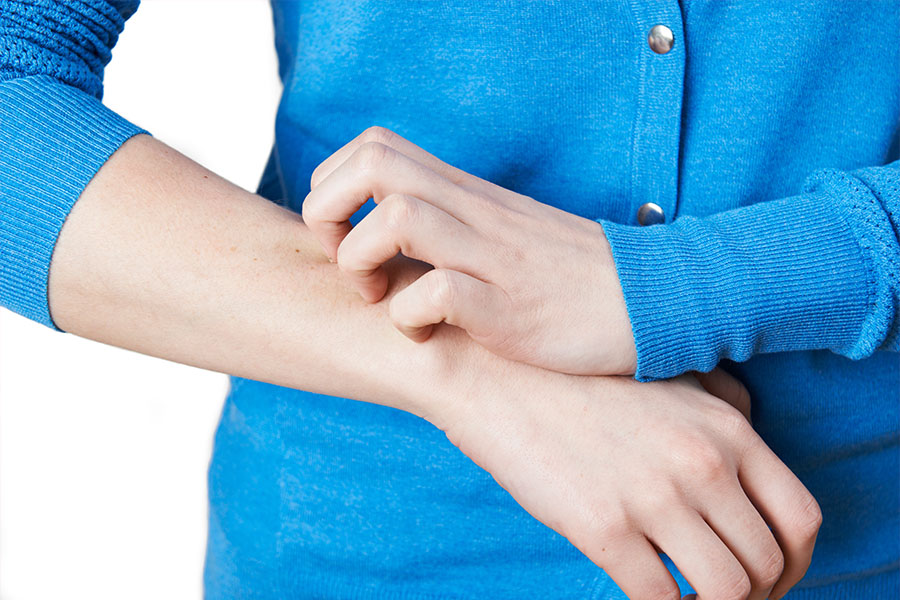Psoriasis vs. Eczema

Chronic skin conditions can be some of the most uncomfortable and embarrassing disorders. Psoriasis and eczema are two of the most common. Although they both tend to result in rashes, they are very different diseases. Understanding them both and their differences can help you understand your treatment options. Here’s a look at what psoriasis and eczema are and the distinct differences between the two.
What is Psoriasis?
The are five major types of psoriasis: plaque, guttate, inverse, pustular, and erythrodermic. Each generally results in some form of a reddened skin rash. Psoriasis is an immune disorder; it encourages the body to make new skin cells faster than the body can shed old ones. Instead of a 30 day cycle like normal skin cells, cells affected by psoriasis regenerate every 3-4 days. Of the major types, plaque psoriasis is the most common. The other four types of psoriasis vary in degrees of severity, triggers, placement, and particularities of the appearance of the rash.
Plaque psoriasis appears as large, scaly areas of rough, red patches, sometimes with a whitish coat of dead skin cells. These areas can be itchy or uncomfortable and occur most often on the elbows, knees, back, and scalp. Treatment for psoriasis can be a combination of topical balms, oral medications, and other therapies. Combining these treatments with lifestyle changes, such as dietary measures and avoiding psoriatic triggers, is generally the best way to manage psoriasis.
Steroid cream can be especially helpful. The purpose of oral medications is generally to suppress the immune system and/or decrease skin rejuvenation. Different types of light therapy can be extremely effective for plaque psoriasis.
What is Eczema?
Eczema is a different type of often chronic skin rash with many different forms as well. Eczema is never contagious, and although some forms are chronic, other types may be a reaction to an allergen or irritant (contact dermatitis). Generally when someone says they have “eczema” they are actually referring to the more common of chronic forms, atopic dermatitis. Other major types of eczema (and/or dermatitis) include dyshidrotic eczema, hand eczema, neurodermatitis, nummular eczema, and stasis dermatitis.
Atopic dermatitis (and many other forms of chronic eczema) often appear during the early years of life, but it is possible the disorder may not appear until adulthood. It too is thought to be rooted in the immune system, but in this case the immune system is overactive. This often occurs in combination with hay fever and/or asthma, making the “atopic triad” of allergy related disorders. Genetics, the environment, a tendency to have sensitive skin, and skin-dwelling bacterium can all play a role.
Eczema appears as reddish, brownish, or greyish patches of skin that become fiercely itchy. Small bumps may pop up, and the area may ooze or leak. The skin can be cracked, scaly, dry, or sensitive and swollen. Treatment for eczema entails a combination of careful skin care. Your doctor may prescribe topical or oral anti-itch medicine, skin repairing creams, topical or oral antibiotics, and anti-inflammatories. Additional therapies include wet dressing, light therapy, and managing stress, which appears to be a strong trigger for eczema.
What’s the Difference?
Psoriasis and eczema both result from immune system issues, but the way the immune system reacts is quite different. Furthermore, experts still don’t completely understand why and how eczema appears. The rashes appear differently; in particular, eczema tends to be itchy while psoriasis tends to be painful (although this is not guaranteed). Additionally, while some forms of eczema can appear and disappear as a response to environmental stimuli (i.e. diaper rash and chemical burns can be forms of contact dermatitis), psoriasis is often in response to an internal trigger, and tends to be quite chronic. If you think you have psoriasis or eczema, talk to your doctor right away to start an appropriate treatment regimen.








